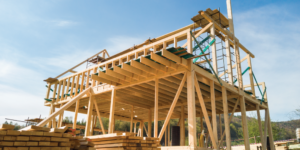
After a year and a half after the cost of wood frames and other lumber-based items started a climb to historic highs, the material’s market price fell for the seventh consecutive week — finally landing around the pre-COVID average by the final week of July 2021, according to Random Length Numbers.
Once at an all-time high of $1,711 per thousand board feet and contributing to several delays and frustrations throughout the industry well into this year, that figure arrived at around $575 on July 30, 2021 signaling a seemingly collective sigh of relief from contractors who have been burnt badly on projects over the course of the pandemic.
While the 65% decrease from former soaring peaks is a welcome sign in the immediate construction landscape, experts caution both builders and consumers that they could see a return to the current norm over the course of the next several months.
So, what exactly should contractors know about the fall of the once-volatile material’s prices — and its impact on projects moving forward in 2021?
Price drop might be hopeful — but change isn’t immediate
Although much buzz was made about the fall to even below 2018’s peak, lumber remains a fickle commodity.
The “cash price” of lumber that suppliers and distributors quote for immediate purchase has fallen and sees many builders purchasing in bulk after shortages and ever-increasing costs prevented many of them from making meaningful headway on their contracted projects, as well as curb significant profit margins on the average added cost of $36,000 to a newly built home.
Explaining why some spec builders are holding on to various projects, Los Angeles-based luxury home builder Yaron Yehoda stated to Forbes that smaller projects are still adversely affected by the market’s high cost of lumber from previous months, and it’s the reason behind some delays.
“Yes, prices have fallen. But you have to look at the huge price they’ve come down from,” Yehoda details. Yehoda says their structures’ starting price-points have ranged from $4 million to $10 million. “Those who build homes for $4 million and under are not building right now.”
In the Midwest, Daene Boomsma, owner of Rapid City, South Dakota’s Boom Construction, is still seeing projects reeling from the past’s record prices.
“We have these conversations with clients all the time, ‘When are prices going to come down, we’re going to wait.’” Boomsa said. “Well, new construction always increases in price.”
Experts caution price drop part of a general trend
As firms race to obtain lumber and other products, the wider contractor pool is overly ecstatic about the telltale signs of stabilization in the material market.
“The worst may actually be behind us for lumber prices,” said CoreLogic Construction Expert Glenn Bearden in a recent company podcast. “Now we’re not expecting a sudden change to pre-pandemic conditions…but we can take some comfort in knowing that science is now directing the COVID virus, with vaccines, cautionary measures that are in place.”
With the country seemingly within sight of life after COVID, analysts caution that a yo-yo effect can lead the market right back to last year’s summit, citing President Biden’s Infrastructure Bill and the countries’ rising cost of homes due to near zero-interest rates as two reasons why lumber could see an equal return to the pandemic norm shortly after it fell from such great heights.
Read the latest August 2021 update on the 2021 Infrastructure Bill.
With $109 billion to be invested in roads and bridges, it’s not without reason that building materials including lumber will increase in demand from this revitalization, on top of the already booming residential home building across the past year.
Citing the potential for a price seesaw, senior market analyst at trading platform IG Joshua Mahony also pointed out that this turnabout in costs is a seasonal industry trend in the second half of most calendar years.
“That reversal historically results in a bullish reversal to regain lost ground and bring us back into a positive end to the year,” Mahony said. “This current pullback is in fact part of a seasonal trend that typically resolves in a dramatic recovery towards the end of the year.”
Such a fall after a tumultuous year might seem like a full-blown return to the normalcy that experts and lumber yards predicted would likely never happen again, however, long-term projects and bids are determined by the unpredictable “futures” market.
For now, this outlook is holding at an optimistic $631.50 — still significantly less than the $800 range that some lumber mills had previously referred to as our “new normal.”
Although patience and the market’s general yearly course have partly played into the long-awaited drop, many suppliers urge both consumers and contractors to avoid flooding the market with overwhelming demand, aiming of keeping the price low compared to the DIY boom of the pandemic shorting the nation’s supply.
“It would be fabulous to be able to tell everyone don’t panic…but we know in a real-world scenario that that’s not the case.” Bearden opined to listeners.
“Be open-minded, and more importantly be patient. Panic buying, what we see with contractors, with materials and housing. This creates a bubble that eventually is going to burst…. and it may put people in a worse place than had they been patient.”